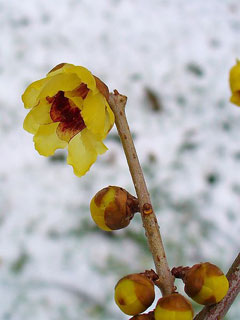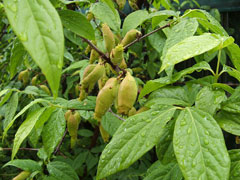 |
|
http://commons.wikimedia.org/wiki/File:Chimonanthus_praecox_003.JPG |
 |
| http://commons.wikimedia.org/wiki/User:Luigi_Chiesa |
Translate this page:
Summary
Bloom Color: Yellow.
Main Bloom Time: Early spring, Late spring, Late winter, Mid spring, Mid winter. Form: Rounded.
Physical Characteristics

 Chimonanthus praecox is a deciduous Shrub growing to 3 m (9ft) by 3 m (9ft) at a medium rate.
Chimonanthus praecox is a deciduous Shrub growing to 3 m (9ft) by 3 m (9ft) at a medium rate.
See above for USDA hardiness. It is hardy to UK zone 7. It is in flower from November to March, and the seeds ripen from May to June. The species is hermaphrodite (has both male and female organs) and is pollinated by Insects.
Suitable for: light (sandy), medium (loamy) and heavy (clay) soils and prefers well-drained soil. Suitable pH: mildly acid, neutral and basic (mildly alkaline) soils and can grow in very alkaline soils.
It cannot grow in the shade. It prefers moist soil.
UK Hardiness Map
US Hardiness Map
Synonyms
C. fragrans. Lindl. Calycanthus praecox. Meratia praecox.
Plant Habitats
Woodland Garden Sunny Edge; Dappled Shade;
Edible Uses
Edible Parts: Flowers
Edible Uses:
Flowers - thoroughly boiled and then washed[179]. Eaten with oil and salt[177, 183]. The flower petals are used to flavour and scent tea[183].
References More on Edible Uses
Medicinal Uses
Plants For A Future can not take any responsibility for any adverse effects from the use of plants. Always seek advice from a professional before using a plant medicinally.
Antiphlogistic Antirheumatic Sialagogue
The flowers and flower buds contain 0.5 - 0.6%.essential oils comprising benzylalcohol, benzyl acetate, linalool, terpineol and indole[266]. They are sialagogue[178, 218]. The flowers are used in the treatment of thirst and depression whilst the essential oil is used to treat colds[266]. The leaves and roots can be used in the treatment of contusions, cuts, haemorrhages, strains, lumbago, rheumatism, numbness and colds[266].
References More on Medicinal Uses
The Bookshop: Edible Plant Books
Our Latest books on Perennial Plants For Food Forests and Permaculture Gardens in paperback or digital formats.

Edible Tropical Plants
Food Forest Plants for Hotter Conditions: 250+ Plants For Tropical Food Forests & Permaculture Gardens.
More

Edible Temperate Plants
Plants for Your Food Forest: 500 Plants for Temperate Food Forests & Permaculture Gardens.
More

More Books
PFAF have eight books available in paperback and digital formats. Browse the shop for more information.
Shop Now
Other Uses
Essential Wood
The flowers are very fragrant, they are used in pot-pourri and to make perfumes[1, 46, 61]. The wood, after soaking in water, polishes to a brilliant black finish[178].
Special Uses
Espalier Scented Plants
References More on Other Uses
Cultivation details
Landscape Uses:
Border, Espalier, Foundation, Massing. Requires a good soil in a sunny sheltered position[164, 200]. Badly drained or compacted soils may cause blotching or yellowing of the leaves[200]. Succeeds in most soils but it seems most at home on chalky ones[219]. A very ornamental plant[1], it is hardy to about -25°c[184]. It is best grown on a sunny wall, however, in order to protect the flowers and induce heavier flowering[11]. The flowers are very fragrant[182], but the plant can be very sparse flowering after cool summers[184]. Plants have a moderate rate of growth[202]. Plants take 5 - 12 years to flower from seed[182, 200]. The var. 'Grandiflorus' comes true from seed and has larger flowers than the type[78]. Plants flower profusely when established and left unpruned[219], if any pruning is necessary then it is best done immediately after flowering[184, 219]. The flowers are produced on the leaf axils of wood 3 - 4 years old[202]. The flowers emit a powerful sweet fragrance which can be smelt 50 yards away. The smell is like jonquil and violets[245]. When the fragrance is inhaled close to for any length of time the smell seems to disappear[245]. Plants in this genus are notably resistant to honey fungus[200]. Special Features:
Not North American native, Fragrant flowers, Attractive flowers or blooms.
References Carbon Farming Information and Carbon Sequestration Information
Temperature Converter
Type a value in the Celsius field to convert the value to Fahrenheit:
Fahrenheit:
The PFAF Bookshop
Plants For A Future have a number of books available in paperback and digital form. Book titles include Edible Plants, Edible Perennials, Edible Trees,Edible Shrubs, Woodland Gardening, and Temperate Food Forest Plants. Our new book is Food Forest Plants For Hotter Conditions (Tropical and Sub-Tropical).
Shop Now
Plant Propagation
Seed - best sown as soon as it is ripe in a cold frame[78, 200]. Pre-soak stored seed in tepid water for two hours, keep warm and moist for 3 days then chill for 5 - 8 weeks and sow in a cold frame[164]. Germination is usually good, though it is often slow and erratic, and takes place in 2 months or more at 13°c[78, 164]. When they are large enough to handle, prick the seedlings out into individual pots and grow them on in a greenhouse for at least their first winter. Plant them out into their permanent positions in late spring or early summer, after the last expected frosts. Cuttings of half-ripe wood, July/August in a frame. Extremely difficult to root[11]. Layering in spring[200] or in July/August[78]. Takes 9 months[78]. Fair to good percentage[78].
Other Names
If available other names are mentioned here
Native Range
TEMPERATE ASIA: China (Anhui Sheng, Fujian Sheng, Guizhou Sheng, Henan Sheng, Hubei Sheng, Hunan Sheng, Jiangsu Sheng, Jiangxi Sheng, Shaanxi Sheng, Shandong Sheng, Sichuan Sheng, Yunnan Sheng, Zhejiang Sheng)
Weed Potential
Right plant wrong place. We are currently updating this section.
Please note that a plant may be invasive in one area but may not in your area so it's worth checking.
Conservation Status
IUCN Red List of Threatened Plants Status :

Growth: S = slow M = medium F = fast. Soil: L = light (sandy) M = medium H = heavy (clay). pH: A = acid N = neutral B = basic (alkaline). Shade: F = full shade S = semi-shade N = no shade. Moisture: D = dry M = Moist We = wet Wa = water.
Now available:
Food Forest Plants for Mediterranean Conditions
350+ Perennial Plants For Mediterranean and Drier Food Forests and Permaculture Gardens.
[Paperback and eBook]
This is the third in Plants For A Future's series of plant guides for food forests tailored to
specific climate zones. Following volumes on temperate and tropical ecosystems, this book focuses
on species suited to Mediterranean conditions—regions with hot, dry summers and cool, wet winters,
often facing the added challenge of climate change.
Read More
Expert comment
Author
(L.)Link.
Botanical References
11200266
Links / References
For a list of references used on this page please go here
Readers comment
© 2010, Plants For A Future. Plants For A Future is a charitable company limited by guarantee, registered in England and Wales. Charity No. 1057719, Company No. 3204567.